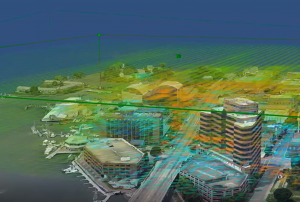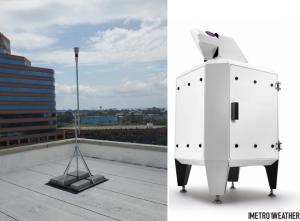TruWeather Solutions Prototypes Urban Weather Sensing Infrastructure
Phase II NASA SBIR Selected to Enhance Weather Sensing Infrastructure for Urban Advanced Air Mobility Operations
RESTON, VA, USA, September 7, 2022 /EINPresswire.com/ -- TruWeather Solutions (TWS), a Northern Virginia based company, has been awarded and is at the inception of a NASA funded Phase II (750,000) SBIR (Small Business Innovation Research) contract for Urban Weather Sensing Infrastructure Testbed in Hampton, Virginia. TruWeather, along with key industry partners, Hampton University, and the City of Hampton, VA will develop a NASA-funded urban weather testbed to demonstrate delivery of more granular weather data and forecast services for low altitude urban and suburban flight to enable weather aware Uncrewed Aerial Systems (UAS) beyond-visual-line-of-sight (BVLOS) operations and the AAM (Advanced Air Mobility) industry.The Hampton testbed aims to advance next-generation weather services required to safely scale profitable UAS and AAM services. The project will take place in a very diverse and challenging weather environment. TruWeather’s goal is to offer a robust urban wind and weather measurement, behavior, and Wind Hazard Information Location (WHILS) prediction service that is scalable to any urban area in the world. It will deliver Elevated Weather Intelligence via software-as-a-service.
TruWeather is partnering with world class science, technology, engineering companies and university researchers to close weather data voids and overcome traditional modeling and computer processing commercialization hurdles. The difference, beyond the TruWeather service and others, is in the ground-based weather sensor systems that collect a greater amount of weather measurements with high enough spatial coverage and rapid refresh in the low altitude environment. Two innovative MetroWeather Doppler Lidars, from Kyoto-based venture MetroWeather, Inc., will provide “MRI-like” wind and potential cloud height information covering over 30-40 area miles and up to 6,000 feet above the ground. The test bed will integrate observations from these lidars, 30 ground sensors, satellite data and potentially a radar to provide services that will provide greater certainty about where and when it is safe for AAM vehicles to operate. The testbed and future systems will inform which routes will provide the most advantageous weather and inform locations selection for terminal operations. The service will enable improvement of UAS and e-VTOL power management, payload weight estimates, travel times and flight separation services to improve airspace traffic management and vertiport throughput allowing more aircraft to arrive and depart safely. The TruWeather services, once fully developed and operational, are planned to be commercially used by The Longbow Group in its PEGASUS Urban Airspace Monitoring and Control Center (UAMCC) to offer UAS and e-VTOL traffic management and vertiport services in Hampton Roads and beyond.
TruWeather continues to expand its portfolio of tools and expertise to enable safe UAS and AAM operations with consortium of world class partners and entrepreneurs including ResilienX, Spire Global, MetroWeather (Japan), Daniel H. Wagner Associates’, WeatherFlow-Tempest, The Longbow Group, and the Hampton University Severe Weather Research Center. TruWeather appreciates the support of the City of Hampton, Virginia, our businesses partners and government agencies that are working toward the creation of the testbed and enabling the installation of 30 micro-weather stations in the downtown district.
The SBIR program and the support of NASA makes this possible. The program is very competitive and provides funding for companies to solve problems, accelerate science, and bring new products or services to market. “We need an adaptive, affordable sensor array to complement weather satellites and weather radar technology and to provide more accurate data to train machine learning models to reliably provide the operational picture required to safely navigate the urban airspace.” said Don Berchoff, TruWeather CEO and former National Weather Service Director for Science and Technology. “We are taking a broader view of this work and also examining how cities can use urban micro weather data collection as part of SMART City initiatives to serve air quality and green energy building management, emergency services and other functions within a city that are impacted by micro-weather on a street-by-street level.”
Hampton Mayor, Donnie Tuck: “Through its relationship with NASA LaRC (Langley Research Center), Hampton has been in the forefront of innovation, and is a national hub for unmanned systems. We are proud to partner with TruWeather as they develop and hone cutting-edge weather technology.”
TruWeather is a global leader in UAS weather innovation for mission critical decisions and operations. TruWeather has an expert analytics system that can easily plug and play new weather sensors, commercial weather data or proprietary micro-scale predictions required to fly uncrewed aircraft long distances BVLOS. To ensure all TruWeather and partner sensor data are reliable, TruWeather partnered with ResilienX on a second NASA Phase II SBIR project to further develop ResilienX’s Weather Sensor Data Monitoring (WSDM) Service, which TruWeather will offer as a service. TruWeather also is supporting Daniel H. Wagner Associates and University of North Dakota in an AFWERXS Phase II STTR Weather Scout Project that seeks to use novel sensors to detect icing and turbulence on a mobile platform at stand-off distance.
About TruWeather Solutions - TruWeather is a leading innovator in micro-weather sensing, modeling, and decision insights for weather-sensitive government activities, industries, and companies. Weather is one of the greatest risks in the Advanced Air Mobility (AAM) ecosystem. Low-level winds, low visibility, icing, and low cloud heights can impact operations regularly. Since current data collection and forecasting methods are not granular enough to routinely capture weather that impacts low-level flight operations, TruWeather focuses on more serviceable micro-weather data for improved flight-time, battery life, and revenue generation per airframe, especially in edge case weather conditions. TruWeather's V360 data analytics platform is one of the few, if not only, micro-weather platform that can plug and play new sensor data, government data and crowd-sourced data on a single web application platform or API. They lead with full spectrum low altitude weather data and are changing the paradigm for how micro-weather is used to optimize UAS flight ops. For more information, contact Lisa Tinnesz, lisa.tinnesz@truweathersolutions.com or truweathersolutions.com
For information on testbed key industry partners, Hampton University, and the City of Hampton, VA, please see full release at https://truweathersolutions.com/weather-sensing-infrastructure/
Lisa Tinnesz
TruWeather Solutions
email us here
Legal Disclaimer:
EIN Presswire provides this news content "as is" without warranty of any kind. We do not accept any responsibility or liability for the accuracy, content, images, videos, licenses, completeness, legality, or reliability of the information contained in this article. If you have any complaints or copyright issues related to this article, kindly contact the author above.


